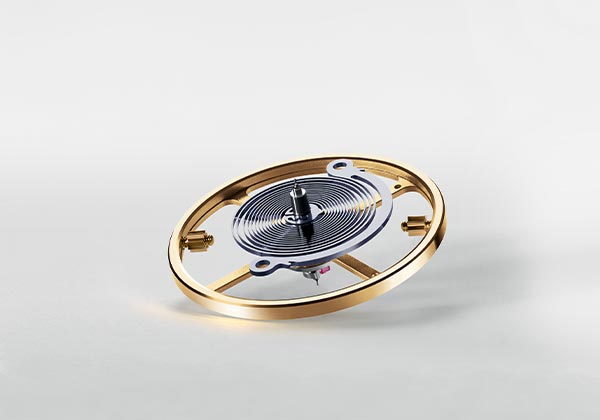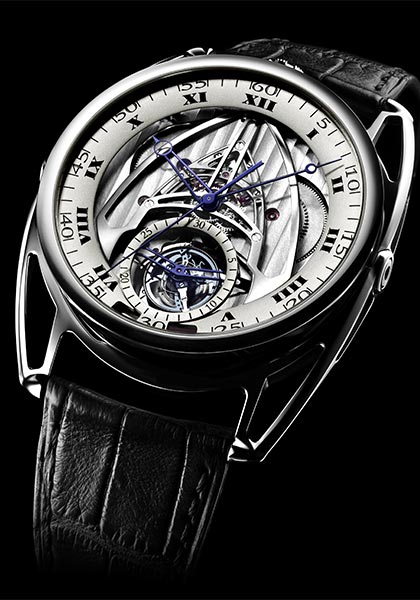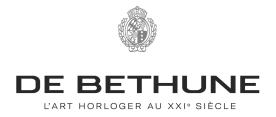Having hunted high and low in the periodic table, watchmakers decided that they should stake their all on number 14: silicon (chemical symbol ‘Si’), the reason being that silicon is light, strong, non-magnetic and less sensitive to variations in temperature. In addition, the related manufacturing processes enable components with highly complex shapes to be produced.
Shared Paternity
In March 2001, Ulysse Nardin presented a breakthrough watch – the Freak – equipped with silicon wheels (later versions also include diamond coated and massive diamond versions), emanating from the research conducted by Ludwig Oechslin and the Swiss Centre for Electronics and Microtechnology (CSEM). While the results obtained were not yet advanced enough to apply the material to elastic applications (as the thermoelastic modulus of silicon alone does not enable a hairspring to operate within the required chronometric tolerances), they aroused the interest of Patek Philippe, Rolex, and the Swatch Group. All three had realised that silicon would deliver a giant leap for watchmaking. And from that point on, the three of them poured funding into further research at the CSEM. The eventual outcome was a satisfactory material: Silinvar – a contraction of the French for ‘invariable silicon’, and a nod to Charles-Edouard Guillaume’s acclaimed Invar alloy.

While the Silinvar consortium (Patek Philippe, Rolex and the Swatch Group) worked together through the CSEM and on their own to reach the promising results, Patek Philippe and the Swatch Group (via Breguet) presented the first timepieces equipped with silicon hairsprings in 2006.

Patek Philippe’s Spiromax hairspring, presented in 2006, was followed in 2008 by the all-new Pulsomax escapement with an improved silicon escape wheel and pallet lever.
Together with the 2011 GyromaxSi, the silicon-based update to their well-known Gyromax variable-inertia balance wheel, these major innovations were brought together to form a single, next-generation concept that was to become the cornerstone of Patek Philippe Advanced Research: the Oscillomax. Breguet presented all three silicon components (escape wheel, anchor and hairspring) in 2006, on the Classique 5197 fitted with the calibre 591A.

Over at Omega, the silicon hairspring made its first appearance in 2008, while Rolex took a similar approach, developing its own spring made from Syloxi – a composite of silicon and silicon oxide, as its name suggests – whose thermal compensation and paramagnetic properties allow it to maintain its precision even in the presence of temperature variations and magnetic anomalies. The Syloxi was introduced on the 2236 calibre in 2014.
When Patents Collide
These three brands were not the only ones to be working in this direction. Ulysse Nardin joined forces with an existing partner, Mimotec, to set up in 2006 a joint venture: Sigatec, an unpretentious little company based in Sion in the canton of Valais specialising in the design and manufacture of silicon components. Ulysse Nardin thus secured itself an independent supply of the material, which, as they rightly guessed, was destined to become a key component of 21st-century watchmaking. Meanwhile, however, Sigatec, in association with Ulysse Nardin, had also filed a large number of patents relating to the same basic material (silicon), with the same research focus (the regulating organ), at around the same time: a legal battle over patents was inevitable. On one side stood Sigatec and Ulysse Nardin; on the other, Patek Philippe, Rolex and the Swatch Group. The feud lasted more than three years, until 2013, but for once, the outcome was in everyone’s common interest. The five parties entered into a cross-licensing agreement, under the terms of which each party opened up their patents to benefit everyone else’s research.

*On the occasion of GMT Magazine and WorldTempus' 20th anniversary, we have embarked on the ambitious project of summarising the last 20 years in watchmaking in The Millennium Watch Book, a big, beautifully laid out coffee table book. This article is an extract. The Millennium Watch Book is available on www.the-watch-book.com, in French and English, with a 10% discount if you use the following code: WT2021.










